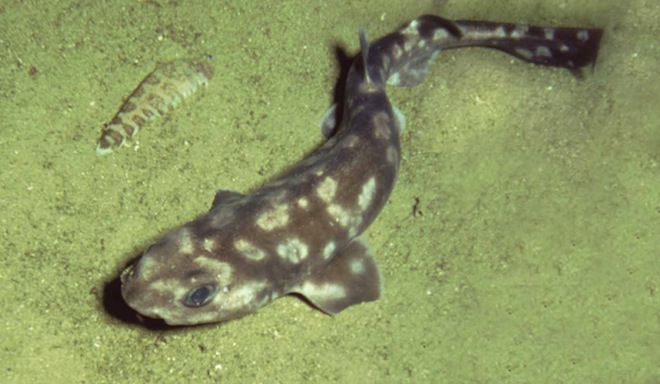Please note: Osher Rainforest will be closed for maintenance Jan. 14–16.
Science News
Science News Round-Up
March 9, 2012

Hints of the Higgs, dinosaurs and a new catshark—our round-up of the week’s science news!
Just as we promised in our article “Things That Go Bump” last month, Fermilab announced big news this week on the Higgs boson. Fermilab’s Tevatron particle accelerator shutdown in September but researchers continue to analyze the data it collected. And, perhaps that data provide evidence of the Higgs, the particle thought to give other particles mass, Nature News reports.
Researchers on the Tevatron see an excess of events produced in the machine’s proton–antiproton collisions that could be caused by a Higgs with a mass between 117 and 131 GeV.
The New York Times is cautiously optimistic:
None of these results… are strong enough for scientists to claim victory. But the recent run of reports has encouraged them to think that the elusive particle, which is the key to mass and diversity in the universe, is within sight, perhaps as soon as this summer.
Much news about dinosaurs this week! More melanosome research has given color to the Microraptor, a pigeon-sized, four-winged dinosaur that lived about 120 million years ago. The study, published in Science today, shows the dinosaur had a glossy black iridescent sheen, almost like a crow, and that its tail was narrow and adorned with a pair of streamer feathers, suggesting the importance of display in the early evolution of feathers.
Also in dino news: a further debate the torosaurus – triceratops relationship—same species or different? Two years ago, researchers thought they were the same species in different stages of growth, but now, other researchers are saying, “Not so fast.” Read more in the New York Times. Want more fossil news action—here are two more headlines for you, in the Times and Discover.
Back to the living… John McCosker, our amazing shark researcher here at the Academy had a new discovery published this week in the journal Zootaxa.
The new catshark, Bythaelurus giddingsi, was found in the Galapagos and is approximately a foot long with pale, irregularly distributed spots on its body. The spotted patterns appear to be unique to each individual.
In the 1990s, McCosker made a series of dives inside the submersible Johnson Sea-Link to explore the marine life on the islands' steep volcanic slopes and sandy bottoms. It was during two such dives in 1995 and 1998 that McCosker collected the seven specimens used to describe B. giddingsi. More info can be found at Wired.